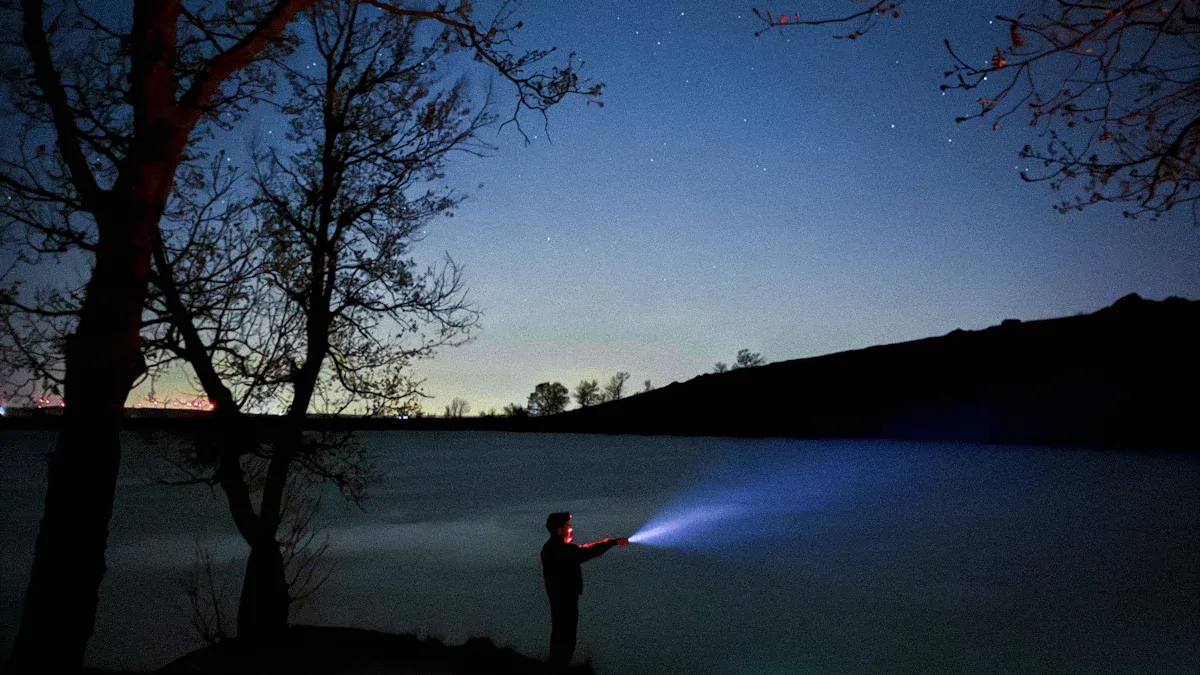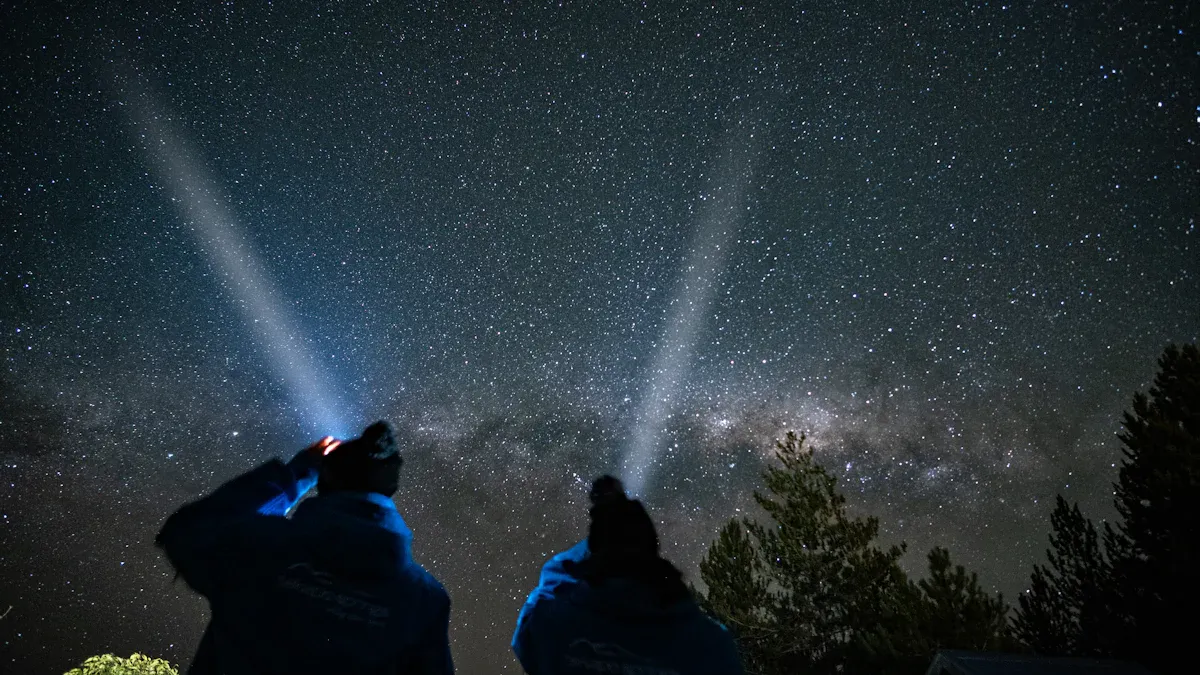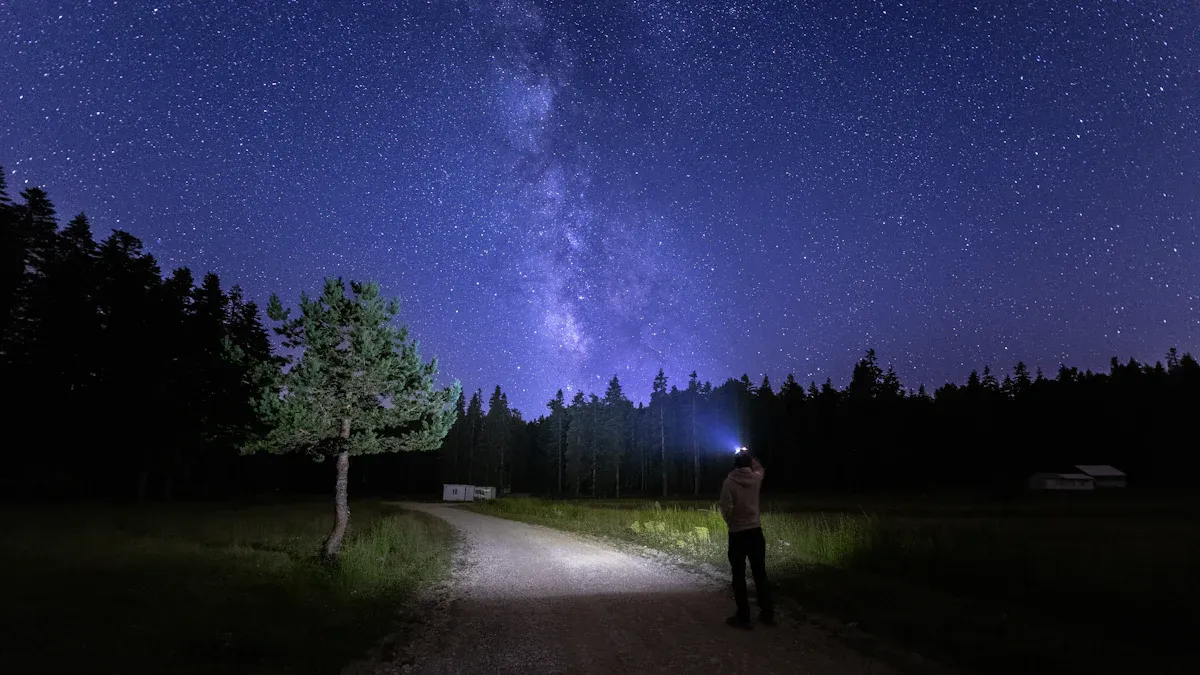Why Flashlights Are Crucial for Wildlife Spotting and Conservation Projects

Flashlights are indispensable tools for observing nocturnal animals and conducting conservation work safely. They allow you to navigate dark environments while reducing the risk of accidents. However, artificial lighting can disrupt wildlife behavior in significant ways:
Bright lights interfere with bird migration, affecting 450 species that rely on celestial navigation.
Sudden illumination blinds nocturnal animals, increasing road kills and disrupting wildlife corridors.
Artificial light alters predator-prey dynamics, forcing prey into prolonged hiding.
Using wildlife-friendly lighting, such as red or amber hues, minimizes these impacts. This approach ensures you can observe animals responsibly without compromising their natural behaviors or habitats.
Key Takeaways
Use animal-safe lights, like red or amber LEDs, to avoid disturbing night animals and their habits.
Stay safe in animal areas by using good flashlights to see dangers and prevent accidents.
Follow smart tips, like not shining lights on animals and using motion detectors, to keep animals safe and protect their homes.
The Importance of Flashlights in Wildlife Spotting

Enhancing Visibility for Nocturnal Observation
Observing nocturnal wildlife requires proper lighting to navigate dark environments effectively. Without adequate illumination, you may face challenges such as disorientation or difficulty spotting animals. Flashlights equipped with LED technology provide a focused beam that enhances visibility without overwhelming the surroundings. This is especially important for minimizing the impact of artificial light on nocturnal species. Animals like owls and bats rely on darkness for foraging and mating. Sudden bright light can disrupt their natural behaviors or even cause temporary blindness, making them vulnerable to predators. Using wildlife-friendly lighting, such as red or amber LEDs, allows you to observe these creatures without interfering with their activities.
Ensuring Safety in Wildlife Habitats
Exploring wildlife habitats at night can pose significant risks. Uneven terrain, hidden obstacles, and encounters with wild animals increase the likelihood of accidents. A reliable flashlight ensures your safety by illuminating potential hazards. LED flashlights are particularly effective due to their durability and energy efficiency, making them ideal for extended use in outdoor environments. Proper lighting also helps prevent fatal collisions with nocturnal animals, such as migrating birds, which may become disoriented by artificial light. By using controlled and directed lighting, you can reduce these risks while ensuring your safety and that of the wildlife around you.
Supporting Conservation Research and Monitoring
Flashlights play a crucial role in conservation projects by aiding researchers in monitoring biodiversity. Accurate data collection often depends on observing nocturnal species in their natural habitats. LED lighting provides consistent illumination, enabling you to document animal behaviors, track movements, and identify species without causing harm. For example, migrating birds can be studied more effectively with minimal disruption when you use wildlife-friendly lighting. This approach not only supports conservation efforts but also helps maintain the delicate balance of ecosystems.
Features of Wildlife-Friendly Lighting

Adjustable Brightness for Varied Conditions
Wildlife-friendly lighting must adapt to diverse environments and activities. Flashlights with adjustable brightness allow you to control the intensity of light based on your surroundings. For example, a dimmer setting works well for close-range observations, while a brighter beam is ideal for navigating uneven terrain. This flexibility ensures you can illuminate areas effectively without overwhelming nocturnal animals. Modern LED flashlights often include adaptive controls, such as motion sensors, which activate only when movement is detected. This feature reduces unnecessary lighting, conserving energy and minimizing disruption to wildlife. By using adjustable brightness, you can balance visibility with ecological responsibility.
Red and Amber Light Options for Minimal Impact
Red and amber LEDs are essential for wildlife-friendly lighting. These wavelengths are less noticeable to animals, reducing disturbances to their natural behaviors. For instance, amber light minimizes insect attraction, helping maintain their habitats and food sources. It also prevents disorientation in species like sea turtles, which are sensitive to traditional white or blue lights. The longer wavelengths of red and amber lighting make them less harmful to wildlife, protecting nocturnal species from light pollution. By choosing these options, you can observe animals responsibly while preserving the integrity of their ecosystems.
Durability and Efficiency for Outdoor Use
Outdoor environments demand flashlights that can withstand harsh conditions. Wildlife-friendly lighting often incorporates durable materials like aluminum or stainless steel, ensuring resistance to wear and tear. Waterproof and shockproof designs protect the flashlight from rain, mud, and accidental drops. Additionally, LED technology enhances energy efficiency, providing longer battery life for extended fieldwork. Features like textured grips and ergonomic designs improve handling, especially during prolonged use. These advancements make wildlife-friendly lighting reliable and practical for conservation projects, allowing you to focus on your work without worrying about equipment failure.
Best Practices for Using Flashlights Around Wildlife
Avoiding Direct Light on Animals
Shining direct light on animals can have severe consequences. Sudden illumination blinds nocturnal species, taking them 10 to 40 minutes to recover their night vision. This temporary blindness increases their vulnerability to predators and road accidents. Artificial light also disrupts wildlife corridors, hindering natural movement across landscapes. Furthermore, exposure to bright light suppresses melatonin production, affecting circadian rhythms and biological functions. For many species, this disruption can misalign reproductive cycles and other critical life activities. To minimize harm, always avoid pointing your flashlight directly at animals. Instead, use indirect or diffused lighting to observe them responsibly.
Using Wildlife-Friendly Lighting Techniques
Adopting wildlife-friendly lighting techniques is essential for preserving biodiversity. Use low-impact wavelengths like amber or red light to reduce disturbances. These colors are less noticeable to animals and help maintain their natural behaviors. Install lights low to the ground to minimize light pollution and prevent skyglow. Motion sensors can further reduce unnecessary light output, conserving energy and protecting nocturnal wildlife. Directional LED optics focus light only where needed, ensuring task-specific lighting without affecting the surrounding environment. By implementing these techniques, you contribute to healthier ecosystems and support wildlife-friendly outdoor lighting practices.
Timing and Positioning for Responsible Illumination
The timing and positioning of your flashlight significantly impact wildlife behavior. Bright lights can disrupt bird migration, affecting hundreds of species that rely on natural light sources for navigation. Predators gain an unfair advantage when prey is exposed to sudden illumination, forcing prey to spend more time hiding. To mitigate these effects, position your flashlight to avoid direct exposure to animals. Use it sparingly and only when necessary. Preserving natural darkness during critical hours helps protect biodiversity and ensures minimal disruption to nocturnal species.
Flashlights are indispensable for wildlife spotting and conservation. They provide essential visibility and safety while enabling non-invasive observation of nocturnal species. Responsible lighting practices, such as using red or amber wavelengths, help reduce light pollution and preserve natural behaviors. This approach fosters healthier ecosystems by mitigating disruptions to circadian rhythms and migration patterns.
"Light at night disrupts natural behavior and can cause injury or death to the animal population. For example, migrating birds don’t realize that the artificial light isn’t day and can disorient birds during their migration."
You can contribute to conservation efforts by adopting wildlife-friendly lighting techniques. Educate others about the importance of reducing environmental impact. Use tools like motion sensors to minimize unnecessary light and preserve natural darkness. Recognize that small changes in lighting practices can make a significant difference in protecting wildlife and their habitats.
FAQ
What type of flashlight is best for wildlife spotting?
Choose a flashlight with adjustable brightness and red or amber light options. These features minimize disturbance to animals while providing sufficient visibility for your activities.
How can you reduce light pollution during wildlife observation?
Use directional lighting and motion sensors to limit unnecessary illumination. Position the flashlight low to the ground and avoid shining it directly at animals or the sky.
Why is red or amber light better for wildlife?
Red and amber lights have longer wavelengths, which are less disruptive to nocturnal species. They help preserve natural behaviors and reduce the risk of disorientation or harm.
See Also
Why Hunting Flashlights Are Crucial for Outdoor Adventures
Choosing Between Lanterns and Flashlights for Camping Trips
Essential LED Flashlights Every Home Should Have Today
